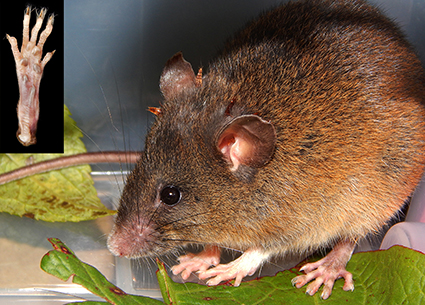Abstract
We describe a distinct new species of the genus Hemiphyllodactylus based on three specimens collected from semi-urban areas in Goa state of India. The new species can be easily distinguished from all peninsular Indian congeners by its small body size (SVL up to 32.4 mm), having 16–18 dorsal scales and 13 or 14 ventral scales at mid-body contained within one longitudinal eye diameter, nine or ten precloacal pores separated by 1–5 poreless scales from a series of 10–12 femoral pores on each thigh in males, lamellar formula of manus 2222 and of pes 2323 & 2333, as well as subtle colour pattern differences. Mitochondrial sequence divergence confirms the distinctiveness of the new species, which is not closely allied to either the South Indian or Eastern Ghats clades of Indian Hemiphyllodactylus and appears to be a member of a third Indian Hemiphyllodactylus clade. Hemiphyllodactylus goaensis sp. nov. is the first member of the genus to be described from the northern Western Ghats region as well as Goa state, and also only the second Indian Hemiphyllodactylus known from < 100 m asl. Hemiphyllodactylus goaensis sp. nov. extends the known distribution of the genus in western India ~ 560 km north in aerial distance and highlights that the genus is more widely distributed than previously thought and most likely contains numerous undescribed species. We also provide final museum numbers for type specimens of H. arakuensis and the holotype of H. kolliensis.
References
Agarwal, I. & Karanth, K.P. (2015) A phylogeny of the only ground-dwelling radiation of Cyrtodactylus (Squamata, Gekkonidae): diversification of Geckoella across peninsular India and Sri Lanka. Molecular Phylogenetics and Evolution, 82, 193–199. https://doi.org/10.1016/j.ympev.2014.09.016
Agarwal, I., Khandekar, A., Giri, V.B., Ramakrishnan, U. & Karanth, P.K. (2019) The hills are alive with geckos! A radiation of a dozen species on sky islands across peninsular India (Squamata: Gekkonidae, Hemiphyllodactylus). Organisms Diversity & Evolution, 19, 341–361. https://doi.org/10.1007/s13127-019-00392-5
Agarwal, I., Bauer, A.M., Pal, S., Srikanthan, A.N. & Khandekar, A. (2020a) Two more new Hemiphyllodactylus Bleeker, 1860 (Squamata: Gekkonidae) from Tamil Nadu, India. Zootaxa, 4729 (2), 249–265. https://doi.org/10.11646/zootaxa.4729.2.6
Agarwal, I., Bauer, A.M. & Khandekar, A. (2020b) A new species of South Asian Cnemaspis (Squamata: Gekkonidae) from the Eastern Ghats, India. Zootaxa, 4802 (3), 449–462.
https://doi.org/10.11646/zootaxa.4802.3.3
Drummond, A.J., Suchard, M.A., Xie, D. & Rambaut, A. (2012) Bayesian phylogenetics with BEAUti and the BEAST 1.7. Molecular Biology & Evolution, 29, 1969–1973. https://doi.org/10.1093/molbev/mss075
Grismer, L.L., Wood, P.L., Jr., Anuar, S., Muin, M.A., Quah, E.S.H., McGuire, J.A., Brown, R.M., Van Tri, N. & Hong Thai, P. (2013) Integrative taxonomy uncovers high levels of cryptic species diversity in Hemiphyllodactylus Bleeker, 1860 (Squamata: Gekkonidae) and the description of a new species from peninsular Malaysia. Zoological Journal of the Linnaean Society, 169, 849–880. https://doi.org/10.1111/zoj.12064
Grismer, L.L., Wood, P.L., Jr., Anuar, S., Quah, E.S.H., Muin, M.A., Onn, C.K., Sumarli, A.X. & Loredo, A. (2015) Repeated evolution of sympatric, palaeoendemic species in closely related, codistributed lineages of Hemiphyllodactylus Bleeker, 1860 (Squamata: Gekkonidae) across a sky island archipelago in peninsular Malaysia. Zoological Journal of the Linnaean Society, 174, 859–876. https://doi.org/10.1111/zoj.12254
Grismer, L.L., Wood Jr., P.L., Thura, M.K., Zin, T., Quah, E.S.H., Murdoch, M.L., Grismer, M.S., Lin, A., Kyaw, H. & Ngwe, L. (2017) Phylogenetic taxonomy of Hemiphyllodactylus Bleeker, 1860 (Squamata: Gekkonidae) with descriptions of three new species from Myanmar. Journal of Natural History, 52 (13–16), 881–915. https://doi.org/10.1080/00222933.2017.1367045
Grismer, L.L., Wood Jr., P.L., Quah, E.S.H., Thura, M.K., Oaks, J.R. & Lin, A. (2020) Four new Burmese species of Hemiphyllodactylus Bleeker (Squamata: Gekkonidae) from distantly related parapatric clades from the Shan Plateau and Salween
Basin. Zootaxa, 4758 (1), 45–82. https://doi.org/10.11646/zootaxa.4758.1.2
Lanfear, R., Calcott, B., Ho, S.Y.W. & Guindon, S. (2012) Partitionfinder: combined selection of partitioning schemes and substitution models for phylogenetic analysis. Molecular Biology & Evolution, 29 (6), 1695–1701. https://doi.org/10.1093/molbev/mss020
Macey, J.R., Larson, A., Ananjeva, N.B., Fang, Z. & Papenfuss, T.J. (1997) Two novel gene orders and the role of light-strand replication in rearrangement of the vertebrate mitochondrial genome. Molecular Biology and Evolution, 14, 91–104. https://doi.org/10.1093/oxfordjournals.molbev.a025706
Miller, M.A., Pfeiffer, W. & Schwartz, T. (2010) Creating the CIPRES Science Gateway for inference of large phylogenetic trees. In: Proceedings of the Gateway Computing Environments Workshop (GCE). Institute of Electrical and Electronics Engineers, Eds., New Orleans, Piscataway, pp. 1–8. https://doi.org/10.1109/GCE.2010.5676129
Mohapatra, P.P., Khandekar, A., Dutta, S.K., Mahapatra, C. & Agarwal, I. (2020) A novel, diminutive Hemiphyllodactylus Bleeker, 1860 (Squamata: Gekkonidae) from a sacred grove in Odisha, eastern India. Zootaxa, 4852 (4), 485–499. https://doi.org/10.11646/zootaxa.4852.4.6
Stamatakis, A. (2006) RAxML-VI-HPC: maximum likelihood-based phylogenetic analyses with thousands of taxa and mixed models. Bioinformatics, 22, 2688–2690. https://doi.org/10.1093/bioinformatics/btl446
Sukprasert, A., Sutthiwises, S., Lauhachinda, V. & Taksintum, W. (2018) Two new species of Hemiphyllodactylus (Squamata: Gekkonidae) from Thailand. Zootaxa, 4369 (3), 363–376. https://doi.org/10.11646/zootaxa.4369.3.4
Sung, Y.-H., Lee, W.-H., Ng, N.-H., Zhang, Y. & Yang, J.-H. (2018) A new species of Hemiphyllodactylus (Squamata: Gekkonidae) from Hong Kong. Zootaxa, 4392 (2), 361–373. https://doi.org/10.11646/zootaxa.4392.2.8
Tamura, K., Peterson, D., Peterson, N., Stecher, G., Nei, M. & Kumar, S. (2011) MEGA5: Molecular evolutionary genetics analysis using maximum likelihood, evolutionary distance, and maximum parsimony methods. Molecular Biology and Evolution, 28, 2731–2739. https://doi.org/10.1093/molbev/msr121
Thompson, J.D., Higgins, D.G. & Gibson, T.J. (1994) CLUSTAL W: improving the sensitivity of progressive multiple sequence alignment through sequence weighting, positions-specific gap penalties and weight matrix choice. Nucleic Acids and Research, 22, 4673–4680. https://doi.org/10.1093/nar/22.22.4673
Zug, G.R. (2010) Speciation and dispersal in a low diversity taxon: the slender geckos Hemiphyllodactylus (Reptilia, Gekkonidae). Smithsonian Contributions to Zoology, 631, 1–70. https://doi.org/10.5479/si.00810282.631


